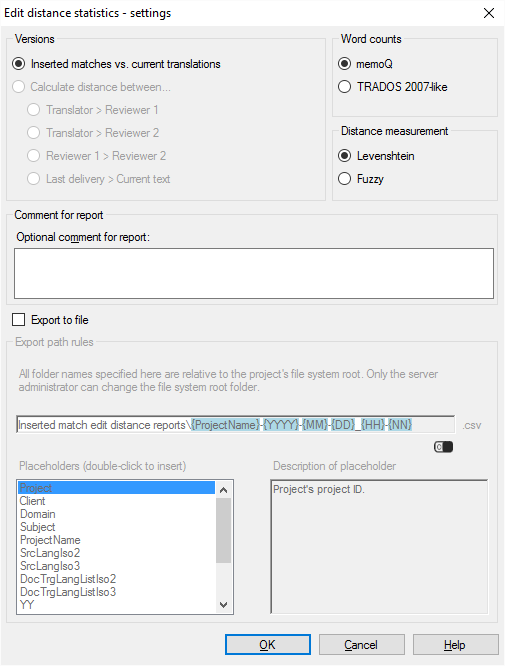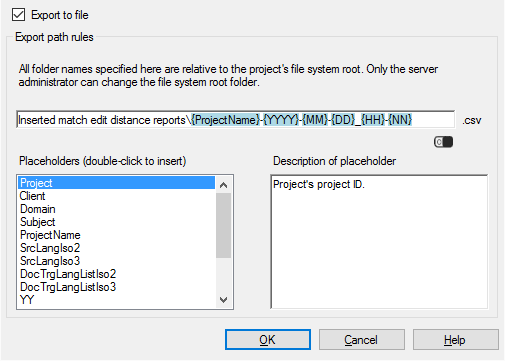Edit distance statistics: translator over matches
Edit distance statistics can measure the work of a translator: It shows how much change they had to make to translation memory matches. memoQ can calculate these automatically in a project that is created from a project template.
Only delivered documents and confirmed segments: The edit distance report gives you numbers for the entire project. But it runs on those documents only that were delivered, and on segments that were confirmed.
Works in online projects only: memoQ doesn't run edit distance statistics in local projects that were created from the project template.
To learn more: See the topic about creating an edit distance report manually.
How to get here
- Open Resource console. Choose Project templates.
To set up a template for online projects: Use an online template for this. Choose your memoQ server at the top of Resource console. Click Select.
- Select the project template that you want to set up with automated actions that use custom scripts. Right-click the selection, and click Edit.
Online projects only: This action isn't available in local projects. If the eye is closed in the top right corner of the Edit project template window, click it.
- In the Edit project template window, choose Automated actions. Click the Project automation tab if you don't see it at first.
- Under Available triggers, click an event when you want memoQ to calculate the edit-distance statistics. For example, if you want to run this after a document is delivered by a translator, click Translator delivers document.
- Next to Actions added to the selected trigger, click the + sign. The Select actions you want to add to the trigger window appears.
- Click Calculate edit distance from inserted matches. The Edit distance statistics - settings window appears.
If you can't add this action because it's already there: Under Actions added to the selected trigger, click Calculate edit distance from inserted matches. Next to the list, click the Settings ![]() button. The Edit distance statistics - settings window appears.
button. The Edit distance statistics - settings window appears.

What can you do?
The Inserted matches vs. current translations radio button is active. You can't change it.
For distance measurement, choose Levenshtein.
To give you an idea of how much the translator worked: This compares the translator's work to the translation memory matches that were inserted in the segments.
To get the amount of work in words, use the Levenshtein method to measure the distance. It makes more sense to see how many words a translator worked - as opposed to how much of the inserted text was changed. In an average translation job, many segments are translated from scratch, without inserting a match first.
Use Fuzzy only if the work was similar to editing: Counting in percent is useful if there was a match for most segments. This happens if you upgrade a translation to a new version of the text, and there is little difference. Or, when there was machine translation and you need to fix machine-translated segments.
Don't use Trados 2007-like word counts: Normally, memoQ counts words like Microsoft Word does. In the past, when Trados 2007 or earlier (Trados Translator's Workbench) used to be a dominant translation tool, it was important that memoQ could produce similar word counts - so that translation companies could compare them. This is no longer the case. Use the Trados 2007-like word counts only if your client still works with an early Trados version, and they insist on using it.
You can save the report automatically on a server in online projects. While the project is running, you can download the reports from the server, from the project file store. The report will always be a .csv file. You can open it in Excel.
- Check the Export to file check box.

- Under Export path rules, set up the folder and name of the report files. You can use placeholders, so that memoQ server takes the name from the name of the project, the date or time when the report was created, the project languages, and so on. memoQ fills in the placeholders with actual details in ongoing projects that are created from this project template.
There is a fixed main folder: memoQ server saves the report to the project's file store. This is a folder on the server. Only a system administrator can change the location of that folder.
Normally, memoQ server saves the reports in a folder called Inserted match edit distance reports, and the name is put together from the name of the project, and the date and time when the report is created.
You can change this: You can add folders to the path, or you can use different placeholders in the name. You can also use these placeholders in the names of the folders. Don't change Inserted match edit distance reports, though.
- Project: Contents of the Project field of the project. This is not the project name.
- Client: Contents of the Client field of the project. Normally, the name of the end-user of the translation.
- Domain: Contents of the Domain field of the project. Normally, the narrower subject or the genre of the source documents.
- Subject: Contents of the Subject field of the project. Normally, the subject field of the source documents.
- ProjectName: The full name of the project. memoQ and memoQ server use this name to identify the project.
- SrcLangIso2: Two-letter code of the source language of the project.
- SrcLangIso3: Three-letter code of the source language of the project.
- TrgLangListIso2: List of two-letter codes of the target languages of the project.
- TrgLangListIso3: List of three-letter codes of the target languages of the project.
- YY: The year when the report is created, in two digits.
- YYYY: The year when the report is created, in four digits.
- MM: The month when the report is created, in two digits.
- DD: The day when the report is created, in two digits.
- HH: The hour when the report is created, in two digits.
- NN: The minutes when the report is created, in two digits.
When you finish
To add the action to the project template: Click OK.
The report won't run when you click OK: To get the analysis report automatically in an ongoing project: Create a project from this project template, and start working on it. Check the Reports or the Overview / Reports section for the new reports.
To return to the Edit project template window, and not add an action to the project template: Click Cancel.